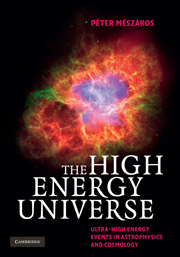Book contents
- Frontmatter
- Dedication
- Contents
- Preface
- 1 Introduction
- 2 The nuts and bolts of the Universe
- 3 Cosmology
- 4 Cosmic structure formation
- 5 Active galaxies
- 6 Stellar cataclysms
- 7 Gamma-ray bursts
- 8 GeV and TeV gamma-rays
- 9 Gravitational waves
- 10 Cosmic rays
- 11 Neutrinos
- 12 Dark dreams, Higgs and beyond
- Epilogue
- References
- Glossary
- Index
12 - Dark dreams, Higgs and beyond
Published online by Cambridge University Press: 05 July 2014
- Frontmatter
- Dedication
- Contents
- Preface
- 1 Introduction
- 2 The nuts and bolts of the Universe
- 3 Cosmology
- 4 Cosmic structure formation
- 5 Active galaxies
- 6 Stellar cataclysms
- 7 Gamma-ray bursts
- 8 GeV and TeV gamma-rays
- 9 Gravitational waves
- 10 Cosmic rays
- 11 Neutrinos
- 12 Dark dreams, Higgs and beyond
- Epilogue
- References
- Glossary
- Index
Summary
Dark matter
As we discussed in Chapter 3, about 26% of the mass-energy density of the Universe at present is in the form of non-relativistic gravitating “matter”, and the rest is in some form of “dark energy”. Considering for now this 26% non-relativistic matter component, about 1/7th of this, or 4% of the grand total, is in the form of known particles, mostly baryons (the leptons, neutrinos and photons represent much less mass than the baryons). The other 6/7th of the non-relativistic matter, or 22% of the grand total, is something which we call “dark matter”, colloquially referred to as DM.
What we know about the dark matter is frustratingly little, but enough to convince us of its existence and to give us an idea of some of its overall properties, as outlined in Chapters 3 and 4. We know that it is there, because its gravity makes itself felt in the dynamics of our galaxy and that of other galaxies, as well as in the dynamics of the expansion of the Universe, and its presence is directly mapped via the “gravitational lensing” effect which distorts the paths of the light rays coming to us from distant objects through foreground dark matter-dominated clusters of galaxies. The DM also plays an important role in determining at what epoch in the expansion of the Universe proto-galaxies start to form and assemble. We also know that it is extremely weakly interacting, if not downright inert. It does not emit, block or reflect light or electromagnetic waves, nor does it seem to interact with other particles, at least not enough to have been detectable so far.
- Type
- Chapter
- Information
- The High Energy UniverseUltra-High Energy Events in Astrophysics and Cosmology, pp. 180 - 193Publisher: Cambridge University PressPrint publication year: 2010



